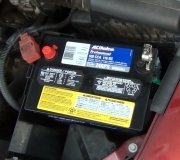Generally speaking we consider a battery to be fully charged when we find it at 12.6 volts, and fully discharged at 12.0 volts. You will often find higher than 12.6 volts right after charging it with a battery charger or by driving the car because some of the electrons haven't been absorbed into the plates. That's called the "surface charge" and must be removed for proper battery testing. That is done by turning on the head lights or anything similar for about ten seconds.
Even when just parking the car after driving it, that surface charge exists so in the case of the 12.69 volts, you can expect the voltage to drop a little as the electrons leave the acid and go into the plates. Typically the voltage will stay near 12.6 volts. 12.42 volts appears to be one third of the way to discharged and that is too fast over three days but those readings can be misleading, or at least inaccurate. Unless specified differently, the industry standard is a good battery will supply all the computer memory circuits and still be able to start the engine after sitting for three weeks. Going just by your voltage readings that means the battery will be too run down to crank the engine after nine days. That implies a drain of three times the allowable.035 amps, or roughly 0.1 amp. Most amplifiers draw more than that when they're on but not amplifying any signal so it should kill the battery in a few days. If you find the battery holds up considerably longer with the amp unplugged, that proves my assertion that the voltage readings do not accurately represent the drain. Just because it's down to 12.42 today, it may not drop another.27 volts in another three days.
Regardless of all my assumptions and observations, I'm hoping you found the cause. You originally said the battery would be dead in three or four days and that would fit with the typical amplifier staying on. The heat is a good clue too although if it does not get warm, it still could be staying on.
Was this helpful?
Yes
No
+2
Saturday, June 30th, 2012 AT 5:47 PM

